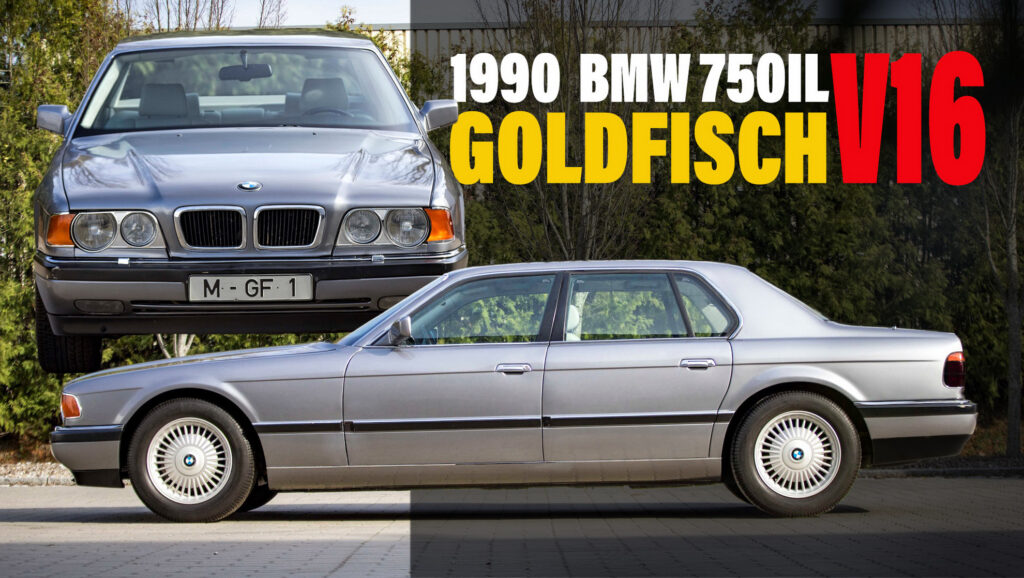This is BMW’s second long-hidden 7-Series prototype powered by the never produced “Goldfisch” V16
3 hours ago
 –>
–> 
–>
- Built in 1990, this 750iL prototype was equipped with BMW‘s “Goldfisch” 6.6-liter V16 engine.
- Although it never made it into production, the automaker claims it produced around 350 hp and was capable of propelling the luxury sedan to a top speed of 155 mph.
- The second long-hidden prototype to emerge from BMW’s secret collection, this car is much less extreme than the 1987 767iL Goldfisch.
Back in the late 1980s, BMW engineers were hard at work creating the ultimate expression of Bavarian luxury, and in their toil, built a 6.6-liter V16 engine. Although promising, this powerhouse was only installed in two different prototype 7-Series sedans, nicknamed Goldfisch, which, regrettably, never had their moment in the spotlight.
While many of you may be familiar with the brown 1987 BMW 767iL V16 Goldfisch from the E32 generation (built between 1986 and 1994) of the 7 Series, there’s a lesser-known secret waiting to be uncovered. It turns out that a few years later, BMW quietly crafted a second version, this time based around a development prototype of the subsequent E32 generation (1995-2001).
Read: BMW 767iL Goldfisch’s V16 Engine Was A Masterpiece That Never Made It Into Production
Given that BMW abandoned the notion of a V16 engine, the 1990 750iL V16 Goldfisch has been tucked away in the brand’s collection for decades. However, breaking its long-standing seclusion, it will make its public debut for the first time ever at the Techno-Classica Essen show in Germany, where BMW will unveil this intriguing prototype to the world.
As evident in a handful of photos shared by BMW, the car boasts all the accoutrements you’d anticipate from the pinnacle of 1990s luxury, featuring cushy seats in the back and a car phone in the front. The prototype looks weird with its E32-like headlights, mirrors, and roofline, in contrast to the sleek production E38— often hailed as the best-looking BMW 7 Series ever. However, that’s unsurprising, as BMW engineers likely utilized one of the early development prototypes of the series.
Under the hood, the massive 6.6-liter V16 is paired with a five-speed automatic transmission, capable of revving to 5,000 RPM and producing 343 hp (256 kW / 348 PS). As a result, it boasts a top speed of 155 mph (250 km/h). While this might not sound like an overwhelming amount of performance, it surpasses the V12 engine found in the production 750i of the time, which could only muster 295 hp (220 kW / 299 PS).
However, it falls short of the power generated by an earlier concept car that BMW unearthed from its collection back in 2019. The 1987 767iL Goldfisch utilized the same 6.6-liter engine but managed to extract a more impressive 402 hp (300 kW / 408 PS). Nevertheless, its cooling requirements were so demanding that the automaker had to install substantial cooling inlets and radiators at the rear.
BMW’s earlier V16 prototype. Source: BMW
While that looked badass, it also took up a lot of space, and we can’t imagine it had a positive impact on the luxury sedan’s storage capacity. I can also understand how BMW executives might have felt that such extravagances were a bit showy for the 7-Series.
That’s certainly not a problem that affects the 1990 750iL V16 Goldfisch, which is a sleeper, as compared to the 767iL. Unfortunately, BMW offers no explanation as to why this car never made it into production either. While that will no doubt disappoint some engine nerds, there is at least good news for them on the V16 front, as Bugatti plans to bring the engine layout back into existence for its next hypercar.